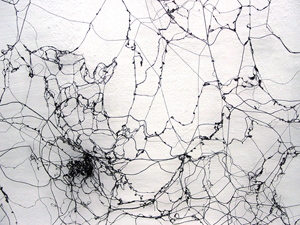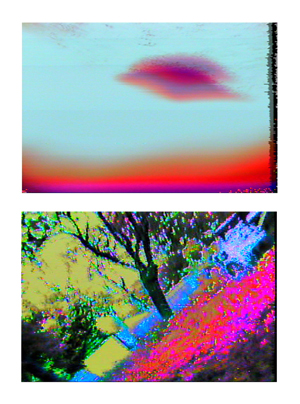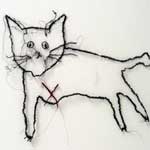The artist Rebecca Carter revels in personal hybridity. She is
comfortable being queer. (For the sake of identity politics, and to
those women out there who might have wanted a date, she’s not gay but
“queer.”)
A protégé and now colleague of the writer, AIDS activist and filmmaker Gregg Bordowitz, Carter is at home in the in-between-ness that constitutes queer. Bordowitz reinforces the queer as an inclusive space: beyond a political banner and rallying cry for gays and lesbians, the queer is a broad, anti-essentialist and unfixed take on identity. If you are “queer” in the way Bordowitz underscores, you might be gay, you might be hetero, but you always are and feel “other” — at home in the uncanny and not-so-comfortable skin you’re in. As Carter puts it, “It’s a logic not of neither/nor, but of both/and.” Queerness is about embracing that Sisyphean rock of alienation that some of us feel so palpably.
In the case of Carter, alienation is productive. It is a force that has led her in beautifully kaleidoscopic directions. After graduating with a degree in studio art / art history and women’s studies from Oberlin in 1993, Carter went on to study at the Penland School of Crafts in the Blue Ridge Mountains of North Carolina and in the Fiber and Material Studies program at the School of the Art Institute of Chicago [SAIC], graduating with an MFA in 2005.
For those of us of the same age who have cut a similarly interdisciplinary path, being queer is part of the zeitgeist, at least on a good day. Sometimes this lyrical road of inquiry and learning has caused Carter discomfort, if only because as an assistant professor of art at SMU in Dallas, being queer stands above and beyond the pale of her more traditional colleagues. But that’s the beauty of it. Ultimately you find your comfort zone, even if surrounded by yesterday’s brokers of the real and the stalwart enforcers of disciplinary and medium boundaries. It’s a tough fight, but the bounty of accepting your queerness is the reward.
Carter’s video-fiber work makes total sense — yes, because of her training, but more poignantly because it is good. Carter’s approach to making art has always been at once conceptual and hands-on, driven by theory and the rudiments of craft. No doubt, this is a result of having attended Penland and the SAIC, particularly a result of the program in which she was enrolled in Chicago — Fiber and Material Studies. This program is rooted in the materiality of the text. “Materiality” here refers to the act of making and, with respect to ontology, to a take on life that is bound up with the everyday in now-time rather than with transcendence and the hereafter. Textual interrogation — ideas such as the “fold” being both a thing and the Deleuzian paradigm of thinking — is fundamental to this course of study. Reading theory, for Carter, is thus paramount to process.
Expatiating on the idea of “hope,” the philosopher Brian Massumi, one of Carter’s favorites, says, “In every situation there are any number of levels of organization and tendencies in play, in cooperation with each other or at cross-purposes.” When looking at Carter’s work, the sentence is both conceptual and real in a very tangible way. In her studio, Carter rolls out How the Mind Works, a large tangle of black thread that she has stitched and woven using sheets of cellulose that she then dissolved in water. Accompanying the piece is a sheet of textual play, words that might or might not be viewed on a screen or gallery wall, saying, “How the Mind Works: (It works and works and works.) How the Mind Works: (Look! This is how.)…”
Other projects in her studio already appear whole and complete, even though they dangle in an in-between phase of her working process. It is the cellulose sheet that achieves this effect. Carter sews thread directly into these sheets, which are creamy white and have a plastic feel to them. They are beautiful just like that, with the skeins of thread embedded in rumpled plastic fields, even though I know her intention is to baptize them in water and set in motion the deliquescence of the cellulose in order to arrive at an oddly figural, fibrous hank of thread.
It is with her current project, The Functionaries of Time Travel, that we find Carter truly embodying the status of “becoming-animal.” For Gilles Deleuze, another of Carter’s preferred writers, “becoming-animal” describes a way of experiencing the world. Becoming-animals are “like hybrids, which are in themselves sterile, born of a sexual union that will not reproduce itself, but which begins over again every time, gaining that much more ground.” Similar to being queer, being a becoming-animal is to somehow not fit in. It is to be the one who doesn’t participate in the hetero-normalcy of getting married, having babies, going to church, believing in God, believing politicians and believing in war. It is to doubt belief. It is also to be a domesticated cat remembering another life in feral terms, roaming the high weeds of Carter’s backyard.
The Functionaries of Time Travel is a video, photo and fiber project based on Carter’s cats and her transition to Dallas. Carter created for her cats black hats with tiny little cameras; she calls them “cat-cams.” Decked out in these floppy fabric chapeaus, the cats wandered the backyard, a feline jungle in miniature made up of North Texan foliage. She has shots of the cats roaming and shots from the cats’ point of view. The photographs, or stills, from the cat-cams are blurred, colorfully pixilated and only vaguely and on occasion representative of the landscape in which the cats stray. A few stills show trees — upside down, turned sideways, giving way to an RGB grid. Carter deploys the mechanical apparatus of the camera set aloft on her cats’ heads in order to bring chance into her work and to distance the artist’s hand. The effect of the stills is somewhere between Nam June Paik’s Zen for TV and Pipilotti Rist’s I’m Not the Girl Who Misses Much. On Carter’s wall dangle doodled cat figures woven in thin air. The woven cats look like children’s drawings, rendered in lines of thread instead of ink or graphite. When Carter sews, her goal is pure thread, not thread on a field of fabric.
In keeping with Carter’s ability to make the unfinished look complete, The Functionaries of Time Travel includes a series of small, bewitching sketches that come across as fully formed ideas and form, even though (in her mind) they are ancillary to something yet to come. In these sketches, Carter’s views on her transition to a new city, Dallas, seem more forthright. The sketches are photographs and collages of an astronaut springing weightlessly in space or along the surface of the moon. She has sewn on and across them in swirling patterns of colored thread.
To say that Carter rethinks the traditionally female arts of sewing and weaving is not so much to be off the mark, or to state the obvious, as it is just to be bland and uninteresting. And this is an injustice when it comes to Carter’s practice as an artist. The real power of her work is its invention. Carter rethinks the sewing machine, thread, fabric and the acts of weaving and sewing in terms of conceptual art. She creates hybrid work that blissfully defies categorization, but feels compositionally whole and complete.
Images courtesy the artist
Charissa N. Terranova is the Assistant Professor of Aesthetic Studies
at UTD and the Director of the UTD Artists Residency Program.









